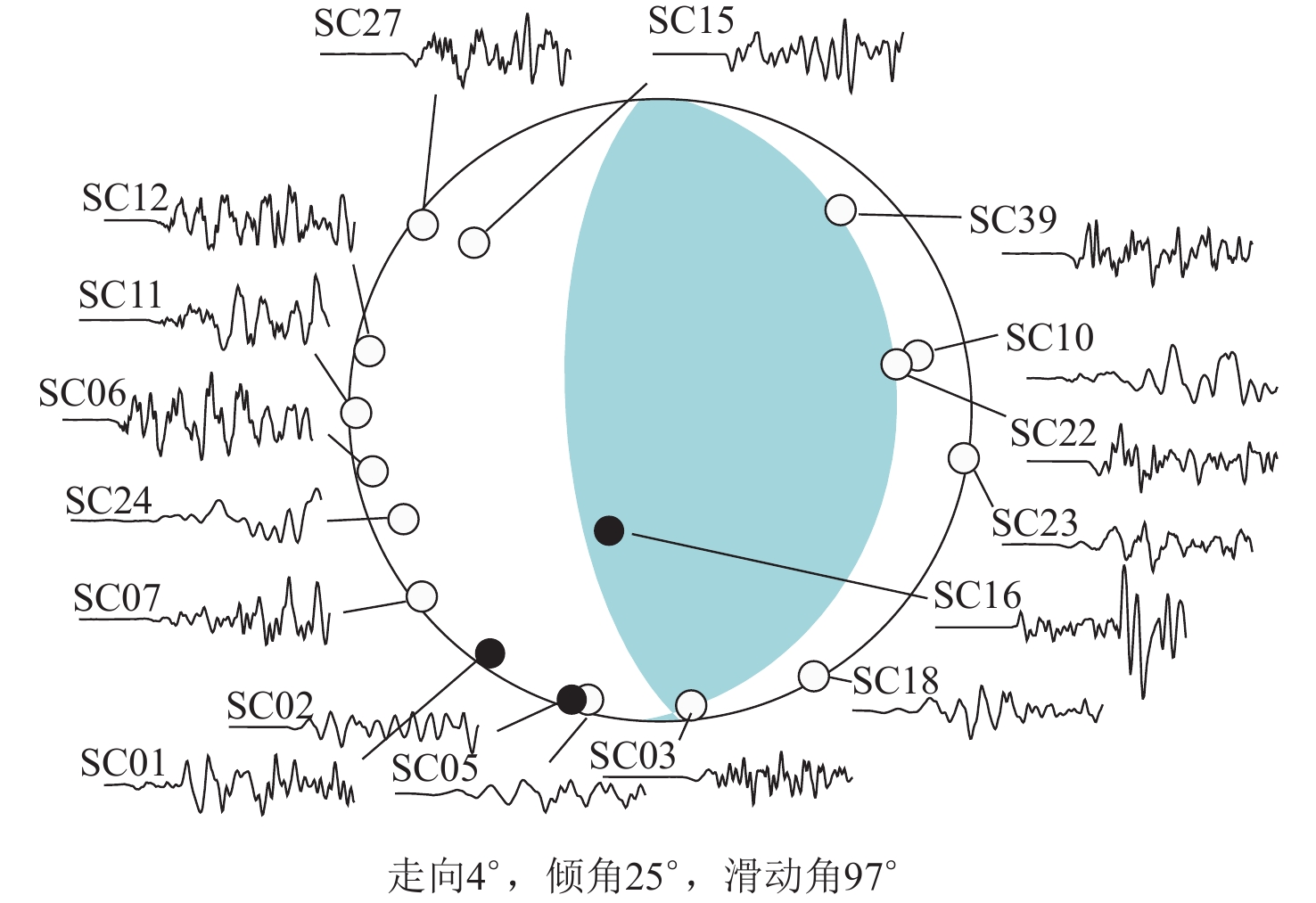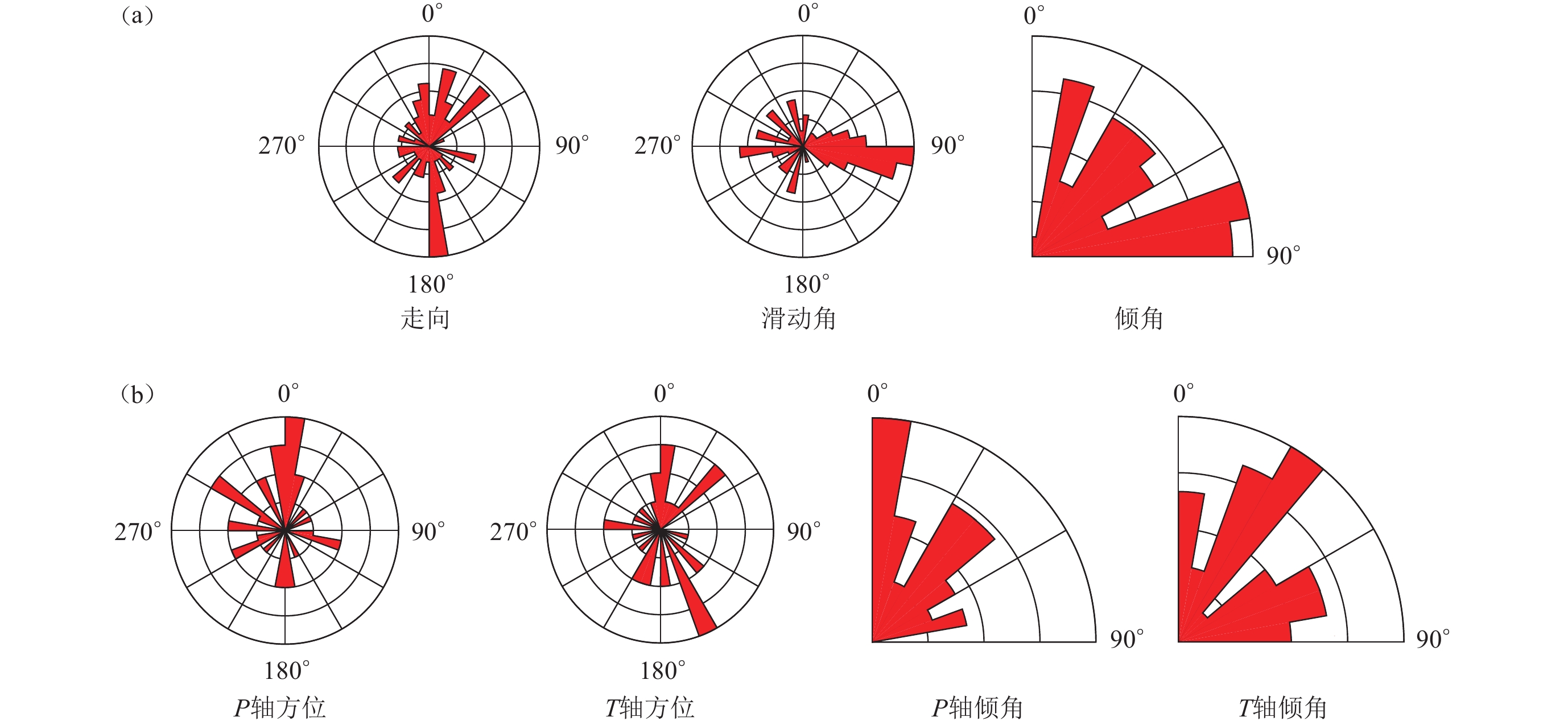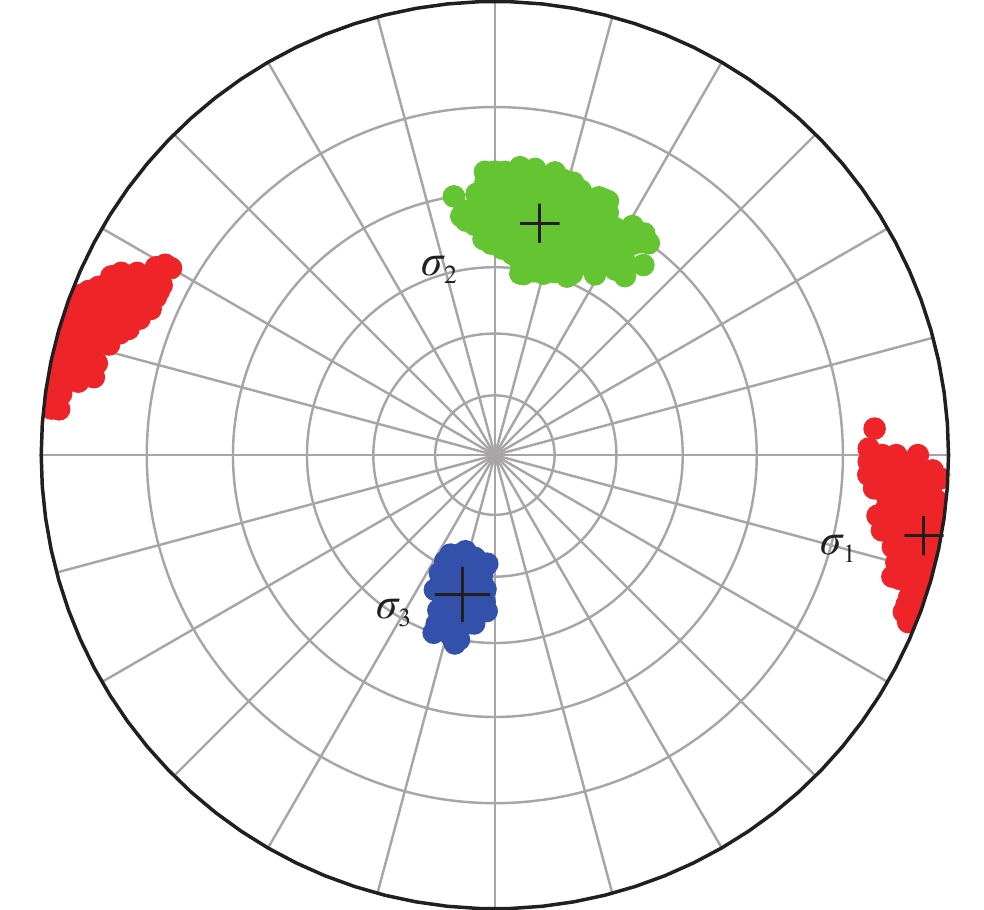Focal mechanism solutions and stress field characteristics of small and moderate earthquakes in Weiyuan area, southern Sichuan basin
-
摘要:
基于四川省威远地区密集流动台站从2019年12月1日至2020年6月30日期间收集到的42个ML3.0—4.5中小地震事件,采用Hypo2000定位法进行精定位,并利用HASH (Hardebeck & Shearer)法反演得到其中31次地震的震源机制解,之后利用阻尼区域应力反演方法计算了研究区的应力场参数。结果表明:中小地震主要分布在威远背斜南翼SSE向墨林场断层的两侧,震源深度集中在10 km以内,均为浅源地震;震源机制解类型以逆冲型为主,断层错动类型较为复杂,根据震源机制解结果,推测墨林场断层两侧存在一系列盲冲断层及正断型断层,同时研究区浅层地层中还可能存在其它小的隐伏断层或破裂;区域应力场为逆冲兼走滑型,其最大主应力轴σ1方位为103°,倾角为1°,最小主应力轴σ3方位为192°,倾角为51°,与震源机制解主要类型具有较好的一致性。
Abstract:Based on the 42 small and moderate events of ML3.0−4.5 recorded by the dense portable stations in Weiyuan area of southern Sichuan basin during the period from December 1, 2019 to June 30, 2020, we used Hypo2000 relocation method to precisely relocate the events. Then we performed the focal mechanism inversion for 31 events among them by HASH (Hardebeck & Shearer) method. And then we used damping spatial and temporal stress inversion method to carry out the inversion for the stress field parameters of the study area. The results indicate that the small and moderate earthquakes are mainly distributed on the SSE-striking Molin fault on the southern flank of the Weiyuan anticline with focal depths concentrating within 10 km, which suggests they are shallow earthquakes. The main type of focal mechanism solutions is thrust, and the type of fault-slip is relatively complex. According to the results of focal mechanism solutions, it is inferred that there are a series of blind thrust faults and normal faults on both sides of the Molin fault. Meanwhile, there may be other small hidden faults or fractures in the shallow strata of the study area. The azimuth of the maximum principal stress σ1 is 103° and the dip is 1°, and the azimuth of the minimum principal stress σ3 is 192° and the dip is 51° in the area. The type of the stress field is thrusting with strike slip, which is consistent with the main type of focal mechanism solutions in the area.
-
1 陈运泰,顾浩鼎。2011。震源理论基础。北京:中国地震局地球物理研究所,北京大学地球与空间科学学院,中国科学院研究生院:38. -
图 3 地震重定位结果 (a)和沿剖面AB (b),CD (c)和EF (d)的震源深度分布
断层F1−F5数据引自高杰(2017),页岩气井数据引自雷兴林等(2020),下同
Figure 3. Relocation results of earthquakes (a) and distribution of focal depths along the sections AB (b),CD (c) and EF (d)
The faults F1−F5 data is taken from Gao (2017),and shale gas well data is taken from Lei et al (2020),the same below
表 1 威远地区的精细速度模型(Lei et al,2017)
Table 1 Fine velocity model in Weiyuan area (Lei et al,2017)
层号 顶层深度/km vP/(km·s−1) vS/(km·s−1) 1 0 5.36 3.12 2 4.1 5.71 3.32 3 7.0 5.81 3.38 4 10.1 5.96 3.46 5 14.0 6.06 3.52 6 16.0 6.23 3.62 7 18.0 6.40 3.72 8 27.0 6.45 3.75 表 2 威远、荣县地区的精细速度模型(易桂喜等,2020)
Table 2 Fine velocity model in Weiyuan and Rongxian areas (Yi et al,2020)
层号 顶层深度/km vP/(km·s−1) vS /(km·s−1) 1 0 5.15 2.98 2 6.0 5.64 3.26 3 8.0 5.72 3.31 4 10.0 5.96 3.45 5 16.0 6.13 3.54 6 18.0 6.22 3.59 7 20.0 6.44 3.72 8 25.0 6.59 3.81 9 28.0 6.71 3.88 表 3 威远地区31个地震震源机制解
Table 3 Focal mechanism solutions of 31 earthquakes in Weiyuan area
序
号事件时间 北纬
/°东经
/°深度
/km节面Ⅰ 节面Ⅱ P轴/° T轴/° B轴/° ML 来源 年-月-日 时:分 走向
/°倾角
/°滑动
角/°走向
/°倾角
/°滑动
角/°方
位倾
角方
位倾
角方
位倾
角1 2019-12-03 12:35 29.48 104.51 6.91 104 69 99 260 23 69 277 23 299 65 11 8 3.2 本文 2 2019-12-12 06:30 29.48 104.52 5.61 39 34 −44 167 67 −116 242 71 5 11 278 15 3.4 本文 3 2019-12-13 18:23 29.50 104.57 0.94 132 59 −20 233 73 −145 6 35 270 9 167 54 3.6 本文 2019-12-13 18:23 29.50 104.54 3.00 141 65 −36 248 58 −150 102 42 196 4 291 47 3.6 郭祥云等(2 022) 4 2019-12-14 09:50 29.60 104.80 5.08 256 80 −49 357 41 −165 114 40 46 24 337 40 3.2 本文 5 2019-12-14 19:03 29.51 104.54 4.64 21 13 118 172 80 84 356 34 343 56 82 6 3.3 本文 6 2019-12-15 11:39 29.64 104.81 6.66 189 15 127 331 79 81 339 32 139 56 63 9 3.1 本文 7 2019-12-19 13:20 29.50 104.53 4.32 17 50 84 205 39 98 19 6 160 82 109 5 3.0 本文 8 2019-12-20 08:52 29.49 104.54 4.35 9 74 −95 208 17 −72 181 61 14 29 281 5 3.7 本文 9 2019-12-21 15:35 29.50 104.53 5.10 21 52 −105 226 39 −70 152 75 32 8 300 12 3.7 本文 10 2019-12-26 16:20 29.45 104.56 2.74 61 9 −41 192 85 −97 4 50 198 39 102 7 3.0 本文 11 2019-12-30 09:24 29.52 104.53 5.00 4 25 97 175 66 86 179 20 350 70 268 3 3.6 本文 2019-12-30 09:24 29.51 104.54 5.00 354 46 99 161 45 81 78 1 342 84 168 6 3.6 郭祥云等(2 022) 2019-12-30 09:24 29.51 104.54 5.00 41 35 91 220 55 89 310 10 127 80 220 1 3.6 易桂喜等(2 020) 12 2020-01-01 02:48 29.49 104.52 8.82 284 10 −150 163 85 −82 354 49 156 39 74 9 3.9 本文 13 2020-01-02 16:26 29.47 104.54 5.30 319 34 −164 215 81 −57 68 44 190 29 120 33 3.2 本文 14 2020-01-09 21:18 29.47 104.53 5.34 42 37 90 222 52 90 222 8 42 82 132 0 3.0 本文 15 2020-01-15 13:00 29.48 104.55 5.02 18 47 109 172 45 70 185 0 273 76 275 14 3.0 本文 16 2020-01-18 08:12 29.47 104.54 2.07 14 37 105 176 56 79 5 8 318 78 94 9 3.2 本文 17 2020-01-24 11:35 29.64 104.80 2.61 136 89 167 227 77 1 272 8 0 10 42 77 3.0 本文 18 2020-02-16 04:28 29.47 104.46 9.56 350 28 90 170 62 90 350 17 350 73 80 0 4.4 本文 19 2020-02-16 21:33 29.41 104.60 5.07 108 51 60 330 48 121 309 2 223 67 38 23 3.2 本文 20 2020-02-25 16:18 29.48 104.54 4.06 15 30 0 285 89 119 258 38 132 38 15 30 3.6 本文 2020-02-25 16:18 29.48 104.54 3.00 354 57 −8 88 83 −147 316 28 217 18 98 56 3.6 郭祥云等(2 022) 21 2020-03-04 12:26 29.49 104.54 3.61 129 46 101 294 45 79 301 0 28 82 31 8 3.0 本文 22 2020-04-05 18:49 29.61 104.57 5.05 341 76 −165 248 77 −19 114 20 204 0 113 70 3.0 本文 23 2020-04-08 18:49 29.42 104.48 4.52 354 12 −95 178 79 −89 0 57 178 33 89 1 3.3 本文 24 2020-04-10 12:23 29.41 104.48 5.07 49 17 0 319 89 107 303 43 155 43 49 17 3.0 本文 25 2020-04-12 11:06 29.42 104.48 4.71 36 16 −72 197 74 −95 10 60 201 30 109 5 3.5 本文 26 2020-04-19 09:05 29.42 104.47 4.55 150 79 −132 48 44 −18 291 41 1 22 250 41 3.2 本文 27 2020-05-27 02:56 29.45 104.58 3.39 42 13 −131 264 80 −81 94 54 256 35 172 8 3.2 本文 28 2020-06-11 07:47 29.47 104.53 4.30 326 41 −108 170 51 −75 45 77 159 5 70 12 3.6 本文 29 2020-06-22 13:08 29.38 104.48 2.68 141 33 45 11 70 114 173 19 47 60 271 23 3.5 本文 2020-06-22 13:08 29.38 104.48 7.00 113 57 40 358 57 140 56 0 326 50 146 40 3.5 郭祥云等(2 022) 30 2020-06-27 00:13 29.47 104.53 3.38 106 14 32 344 83 102 334 37 178 51 73 12 3.5 本文 31 2020-06-30 02:32 29.40 104.50 2.93 40 26 54 259 70 106 247 23 104 62 343 15 3.1 本文 表 4 HASH法震源机制解质量分布标准(郭祥云等,2017)
Table 4 Quality distribution criteria of focal mechanism solutions for HASH (Guo et al,2017)
质量
分类平均
误差断层面不
确定度台站
分布比最佳机制
解概率A ≤0.15 ≤10° ≥0.7 ≥0.9 B ≤0.20 ≤20° ≥0.6 ≥0.85 C ≤0.30 ≤30° ≥0.5 ≥0.80 D 相邻台站最大方位角间隔≤90°,离源角≤60° 表 5 震源机制解分类标准(Zoback,1992)
Table 5 Classification criteria of focal mechanism solution (Zoback,1992)
地震类型 P轴倾角 B轴倾角 T轴倾角 正断型 ≥52° ≤35° 正走滑型 40°≤倾角<52° ≤20° 走滑型 <40° ≥45° ≤20° ≤20° ≥45° <40° 逆走滑型 ≤20° 40°≤倾角<52° 逆断型 ≤35° ≥52° 无法确定型 上述类型之外的震源机制解 表 6 研究区区域应力场反演结果
Table 6 Inversion result of regional stress field in the study area
σ1轴 σ2轴 σ3轴 R值 方位/° 倾角/° 方位/° 倾角/° 方位/° 倾角/° 最优解 103 1 11 39 192 51 0.35 95%置信区间 89—112 0—14 353—360,0—36 26—47 180—208 43—65 0.12—0.50 -
陈朝伟,项德贵,张丰收,安孟可,尹子睿,蒋振源. 2019. 四川长宁—威远区块水力压裂引起的断层滑移和套管变形机理及防控策略[J]. 石油科学通报,4(4):364–377. Chen Z W,Xiang D G,Zhang F S,An M K,Yin Z R,Jiang Z Y. 2019. Fault slip and casing deformation caused by hydraulic fracturing in Changning-Weiyuan blocks,Sichuan:Mechanism and prevention strategy[J]. Petroleum Science Bulletin,4(4):364–377 (in Chinese).
崔效锋,谢富仁,张红艳. 2006. 川滇地区现代构造应力场分区及动力学意义[J]. 地震学报,28(5):451–461. doi: 10.3321/j.issn:0253-3782.2006.05.001 Cui X F,Xie F R,Zhang H Y. 2006. Recent tectonic stress field zoning in Sichuan-Yunnan region and its dynamic interest[J]. Acta Seismologica Sinica,28(5):451–461 (in Chinese).
邓起东,张培震,冉勇康,杨晓平,闵伟,陈立春. 2003. 中国活动构造与地震活动[J]. 地学前缘,10(增刊):66–73. Deng Q D,Zhang P Z,Ran Y K,Yang X P,Min W,Chen L C. 2003. Active tectonics and earthquake activities in China[J]. Earth Science Frontiers,10(S):66–73 (in Chinese).
杜广宝,吴庆举,张雪梅,张瑞青. 2021. 四川威远及邻区中小地震活动特征及地壳精细结构研究[J]. 地球物理学报,64(11):3983–3996. doi: 10.6038/cjg2021O0452 Du G B,Wu Q J,Zhang X M,Zhang R Q. 2021. Activity characteristics of moderate and small earthquakes and fine crustal feature beneath Weiyuan,Sichuan and adjacent areas[J]. Chinese Journal of Geophysics,64(11):3983–3996 (in Chinese).
高杰. 2017. 威远地区页岩气开发对环境影响的地质因素[D]. 成都: 西南石油大学: 9−10. Gao J. 2017. Geological Factors Affecting the Environment of Shale Gas Development in Weiyuan Area[D]. Chengdu: Southwest Petroleum University: 9−10 (in Chinese).
谷志东,闫淑玉,张波,张进江. 2012. 川中威远低缓隆起区三叠系地层中的构造解耦记录及其构造暗示[J]. 北京大学学报(自然科学版),48(2):262–272. Gu Z D,Yan S Y,Zhang B,Zhang J J. 2012. Triassic tectonic decoupling in Weiyuan uplift (Sichuan) and its implications[J]. Acta Scientiarum Naturalium Universitatis Pekinensis,48(2):262–272 (in Chinese).
国家地震科学数据中心. 2020. 中国地震台网统一地震目录[EB/OL]. [2022-03-08]. https://data.earthquake.cn/datashare/report.shtml?PAGEID=earthquake_zhengshi. National Earthquake Data Center. 2020. China earthquake networks earthquake catalog[EB/OL]. [2022-03-08]. https://data.earthquake.cn/datashare/report.shtml?PAGEID=earthquake_zhengshi (in Chinese).
郭祥云,陈学忠,王生文,王恒信. 2014. 川滇地区中小地震震源机制解及构造应力场的研究[J]. 地震工程学报,36(3):599–607. doi: 10.3969/j.issn.1000-0844.2014.03.0599 Guo X Y,Chen X Z,Wang S W,Wang H X. 2014. Focal mechanism of small and moderate earthquakes and tectonic stress field in Sichuan-Yunnan areas[J]. China Earthquake Engineering Journal,36(3):599–607 (in Chinese).
郭祥云,蒋长胜,王晓山,田鑫. 2017. 鄂尔多斯块体周缘中小地震震源机制及应力场特征[J]. 大地测量与地球动力学,37(7):675–685. doi: 10.14075/j.jgg.2017.07.003 Guo X Y,Jiang C S,Wang X S,Tian X. 2017. Characteristics of small to moderate focal mechanism solutions stress field of the Circum-Ordos block[J]. Journal of Geodesy and Geodynamics,37(7):675–685 (in Chinese).
郭祥云, 蒋长胜, 韩立波, 尹海权, 赵志远. 2022. 中国大陆及邻区震源机制数据集(2009—2021年)[DB/OL]. [2022-03-08]. https://data.earthquake.cn. doi: 10.12080/nedc.11.ds.2022.0004 or CSTR: 12166.11.ds.2022.0004. Guo X Y, Jiang C S, Han L B, Yin H Q, Zhao Z Y. 2022. Focal mechanism data set in Chinese mainland and its adjacent area (2009−2021)[DB/OL]. [2022-03-08]. https://data.earthquake.cn. doi: 10.12080/nedc.11.ds.2022.0004 or CSTR: 12166.11.ds.2022.0004 (in Chinese).
韩文雯. 2017. 威远穹窿构造地质遗迹调查与开发研究[D]. 成都: 西南石油大学: 11–12. Han W W. 2017. Research on Investigation and Development of Geological Relics of Weiyuan Dome Structure[D]. Chengdu: Southwest Petroleum University: 11–12 (in Chinese).
何超红,谭孝成,黄成智. 2015. 威远县地质灾害发育规律及成因分析[J]. 防灾科技学院学报,17(1):7–11. doi: 10.3969/j.issn.1673-8047.2015.01.002 He C H,Tan X C,Huang C Z. 2015. Development patterns and formation mechanisms of geological hazards in Weiyuan county[J]. Journal of Institute of Disaster Prevention,17(1):7–11 (in Chinese).
黄骥超,万永革,盛书中,李祥,高熹微. 2016. 汤加—克马德克俯冲带现今非均匀应力场特征及其动力学意义[J]. 地球物理学报,59(2):578–592. doi: 10.6038/cjg20160216 Huang J C,Wan Y G,Sheng S Z,Li X,Gao X W. 2016. Heterogeneity of present-day stress field in the Tonga-Kermadec subduction zone and its geodynamic significance[J]. Chinese Journal of Geophysics,59(2):578–592 (in Chinese).
可以,孙玮,李泽奇,邓宾,汪玉贞,何若玮. 2022. 四川威远地区地震活动与地质条件的关系[J]. 成都理工大学学报(自然科学版),49(1):104–110. doi: 10.3969/j.issn.1671-9727.2022.01.10 Ke Y,Sun W,Li Z Q,Deng B,Wang Y Z,He R W. 2022. The relationship between seismic activity and geological conditions in Weiyuan area,Sichuan,China[J]. Journal of Chengdu University of Technology (Science &Technology Edition),49(1):104–110 (in Chinese).
孔维林,黄禄渊,姚瑞,杨树新. 2021. 川滇地区应力场研究进展[J]. 地球物理学进展,36(5):1853–1864. doi: 10.6038/pg2021FF0171 Kong W L,Huang L Y,Yao R,Yang S X. 2021. Review of stress field studies in Sichuan-Yunnan region[J]. Progress in Geophysics,36(5):1853–1864 (in Chinese).
雷兴林,苏金蓉,王志伟. 2020. 四川盆地南部持续增长的地震活动及其与工业注水活动的关联[J]. 中国科学:地球科学,50(11):1505–1532. Lei X L,Su J R,Wang Z W. 2020. Growing seismicity in the Sichuan basin and its association with industrial activities[J]. Science China Earth Sciences,63(11):1633–1660. doi: 10.1007/s11430-020-9646-x
李英强. 2018.龙门山与四川盆地结合带的地质结构与成因机制[D].北京: 中国地质大学(北京): 66−71. Li Y Q. 2018. Geological Architecture and Formation Mechanism of the Transitional Zone Between Longmenshan Mountains and Sichuan Basin[D]. Beijing: China University of Geosciences (Beijing): 66−71 (in Chinese).
刘树根,马永生,孙玮,蔡勋育,刘顺,黄文明,徐国盛,雍自权,王国芝,汪华,盘昌林. 2008. 四川盆地威远气田和资阳含气区震旦系油气成藏差异性研究[J]. 地质学报,82(3):328–337. Liu S G,Ma Y S,Sun W,Cai X Y,Liu S,Huang W M,Xu G S,Yong Z Q,Wang G Z,Wang H,Pan C L. 2008. Studying on the differences of Sinian natural gas pools between Weiyuan gas field and Ziyang gas-brone area,Sichuan Basin[J]. Acta Geologica Sichuan,82(3):328–337 (in Chinese).
骆佳骥,崔效锋,胡幸平,朱敏杰. 2012. 川滇地区活动块体划分与现代构造应力场分区研究综述[J]. 地震研究,35(3):309–317. doi: 10.3969/j.issn.1000-0666.2012.03.003 Luo J J,Cui X F,Hu X P,Zhu M J. 2012. Research review of the division of active blocks and zoning of recent tectonic stress field in Sichuan-Yunnan region[J]. Journal of Seismological Research,35(3):309–317 (in Chinese).
祁林,蒋能强,孙林松. 1994. 四川地区近代地应力场与发震机制规律探讨[J]. 四川地质学报,14(2):81–87. Qi L,Jiang N Q,Sun L S. 1994. On present ground stress field and earthquake-triggering mechanism in Sichuan[J]. Acta Geologica Sichuan,14(2):81–87 (in Chinese).
苏珊. 2019. 安宁河断裂及周边地区震源机制解与应力场分布特征[D]. 北京: 中国地震局地球物理研究所: 9–17. Su S. 2019. Study on Focal Mechanism and Stress Field Distribution in the Anninghe Fault Zone and Its Surrounding Areas[D]. Beijing: Institute of Geophysics, China Earthquake Administration: 9–17 (in Chinese).
万永革,吴逸民,盛书中,沈正康,万迪. 2011. P波极性数据所揭示的台湾地区三维应力结构的初步结果[J]. 地球物理学报,54(11):2809–2818. doi: 10.3969/j.issn.0001-5733.2011.11.011 Wan Y G,Wu Y M,Sheng S Z,Shen Z K,Wan D. 2011. Preliminary result of Taiwan 3-D stress field from P wave polarity data[J]. Chinese Journal of Geophysics,54(11):2809–2818 (in Chinese).
万永革. 2020. 震源机制与应力体系关系模拟研究[J]. 地球物理学报,63(6):2281–2296. doi: 10.6038/cjg2020M0472 Wan Y G. 2020. Simulation on relationship between stress regimes and focal mechanisms of earthquakes[J]. Chinese Journal of Geophysics,63(6):2281–2296 (in Chinese).
王承伟,李恩来,王帅,安祥宇,赵倩,杨振鹏. 2016. 地震定位方法适用性分析[J]. 防灾减灾学报,32(1):69–74. doi: 10.13693/j.cnki.cn21-1573.2016.01.012 Wang C W,Li E L,Wang S,An X Y,Zhao Q,Yang Z P. 2016. Applicalbility analysis of seismic locating method[J]. Journal of Disaster Prevention and Reduction,32(1):69–74 (in Chinese).
王晓山,吕坚,谢祖军,龙锋,赵小艳,郑勇. 2015. 南北地震带震源机制解与构造应力场特征[J]. 地球物理学报,58(11):4149–4162. doi: 10.6038/cjg20151122 Wang X S,Lü J,Xie Z J,Long F,Zhao X Y,Zheng Y. 2015. Focal mechanisms and tectonic stress field in the North-South Seismic Belt of China[J]. Chinese Journal of Geophysics,58(11):4149–4162 (in Chinese).
徐锡伟,郭婷婷,刘少卓,于贵华,陈桂华,吴熙彦. 2016. 活动断层避让相关问题的讨论[J]. 地震地质,38(3):477–502. doi: 10.3969/j.issn.0253-4967.2016.03.001 Xu X W,Guo T T,Liu S Z,Yu G H,Chen G H,Wu X Y. 2016. Discussion on issues associated with setback distance from active fault[J]. Seismology and Geology,38(3):477–502 (in Chinese).
许忠淮,汪素云,黄雨蕊,高阿甲,金小锋,常向东. 1987. 由多个小震推断的青甘和川滇地区地壳应力场的方向特征[J]. 地球物理学报,30(5):476–486. Xu Z H,Wang S Y,Huang Y R,Gao A J,Jin X F,Chang X D. 1987. Directions of mean stress axes in southwestern China deduced from microearthquake data[J]. Chinese Journal of Geophysics,30(5):476–486 (in Chinese).
杨程宇,文龙,王铁冠,罗冰,李美俊,田兴旺,倪智勇. 2020. 川中隆起安岳气田古油藏成藏时间厘定[J]. 石油与天然气地质,41(3):492–502. doi: 10.11743/ogg20200306 Yang C Y,Wen L,Wang T G,Luo B,Li M J,Tian X W,Ni Z Y. 2020. Timing of hydrocarbon accumulation for paleo-oil reservoirs in Anyue gas field in Chuanzhong Uplift[J]. Oil &Gas Geology,41(3):492–502 (in Chinese).
杨光宇. 1985. 我国西南川滇地区强震活动与构造应力场的研究[J]. 地震研究,8(3):329–338. Yang G Y. 1985. A study on strong earthquake activities and structural stress field in the Sichuan-Yunnan area,southwest China[J]. Journal of Seismological Research,8(3):329–338 (in Chinese).
易桂喜,龙锋,梁明剑,赵敏,王思维. 2020. 四川盆地荣县—威远—资中地区发震构造几何结构与构造变形特征:基于震源机制解的认识和启示[J]. 地球物理学报,63(9):3275–3291. doi: 10.6038/cjg2020O0095 Yi G X,Long F,Liang M J,Zhao M,Wang S W. 2020. Geometry and tectonic deformation of seismogenic structures in the Rongxian-Weiyuan-Zizhong region,Sichuan basin:Insights from focal mechanism solutions[J]. Chinese Journal of Geophysics,63(9):3275–3291 (in Chinese).
喻颐,李忠权,杨渊宇,应文峰,杭文艳. 2013. 四川盆地威远地区构造演化特征及其对下古生界油气富集的控制作用[J]. 天然气勘探与开发,36(2):1–4. doi: 10.3969/j.issn.1673-3177.2013.02.001 Yu Y,Li Z Q,Yang Y Y,Ying W F,Hang W Y. 2013. Characteristics of tectonic evolution of Weiyuan area in Sichuan basin and its effect on lower Paleozoic oil and gas reservoirs[J]. Natural Gas Exploration &Development,36(2):1–4 (in Chinese).
朱航,何畅. 2014. 注水诱发地震序列的震源机制变化特征:以四川长宁序列为例[J]. 地球科学:中国地质大学学报,39(12):1776–1782. Zhu H,He C. 2014. Focal mechanism changing character of earthquake sequence induced by water injection:A case study of Changning sequence,Sichuan Province[J]. Earth Science:Journal of China University of Geosciences,39(12):1776–1782 (in Chinese). doi: 10.3799/dqkx.2014.161
Guiraud M,Laborde O,Philip H. 1989. Characterization of various types of deformation and their corresponding deviatoric stress tensors using microfault analysis[J]. Tectonophysics,170(3/4):289–316.
Hardebeck J L,Shearer P M. 2002. A new method for determining first-motion focal mechanisms[J]. Bull Seismol Soc Am,92(6):2264–2276. doi: 10.1785/0120010200
Hardebeck J L,Shearer P M. 2003. Using S/P amplitude ratios to constrain the focal mechanisms of small earthquakes[J]. Bull Seismol Soc Am,93(6):2434–2444. doi: 10.1785/0120020236
Hardebeck J L,Michael A J. 2006. Damped regional-scale stress inversions:Methodology and examples for southern California and the Coalinga aftershock sequence[J]. J Geophys Res:Solid Earth,111(B11):B11310.
Klein F W. 1978. Hypocenter Location Program HYPOINVERSE: U.S. Geological Survey Open-File Report 78-694[R]. Menlo Park: USGS: 113.
Lei X L,Yu G Z,Ma S L,Wen X Z,Wang Q. 2008. Earthquakes induced by water injection at ~3 km depth within the Rongchang gas field,Chongqing,China[J]. J Geophys Res:Solid Earth,113(B10):310.
Lei X L,Huang D J,Su J R,Jiang G M,Wang X L,Wang H,Guo X,Fu H. 2017. Fault reactivation and earthquakes with magnitudes of up to MW4.7 induced by shale-gas hydraulic fracturing in Sichuan basin,China[J]. Sci Rep,7(1):7971. doi: 10.1038/s41598-017-08557-y
Martínez‐Garzón P,Kwiatek G,Ickrath M,Bohnhoff M. 2014. MSATSI:A Matlab package for stress inversion combining solid classic methodology,a new simplified user‐handling,and a visualization tool[J]. Seismol Res Lett,85(4):896–904. doi: 10.1785/0220130189
Michael A J. 1984. Determination of stress from slip data:Faults and folds[J]. J Geophys Res:Solid Earth,89(B13):11517–11526. doi: 10.1029/JB089iB13p11517
Wang M M,Yang H F,Fang L H,Han L B,Jia D,Jiang D Q,Yan B. 2020. Shallow faults reactivated by hydraulic fracturing:The 2019 Weiyuan earthquake sequences in Sichuan,China[J]. Seismol Res Lett,91(6):3171–3181. doi: 10.1785/0220200174
Wessel P,Smith W H F. 1995. New version of the generic mapping tools[J]. Eos Trans Am Geophys Union,76(33):329.
Yang H F,Zhou P C,Fang N,Zhu G H,Xu W B,Su J R,Meng F B,Chu R S. 2020. A shallow shock:The 25 February 2019 ML4.9 earthquake in the Weiyuan shale gas field in Sichuan,China[J]. Seismol Res Lett,91(6):3182–3194. doi: 10.1785/0220200202
Zoback M L. 1992. First- and second-order patterns of stress in the lithosphere:The World Stress Map Project[J]. J Geophys Res:Solid Earth,97(B8):11703–11728.





 下载:
下载:







